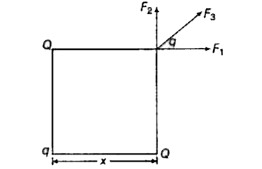The opposite corners of square carry Q charges each and the other two opposite corners of the same square carry q charges each. If the resultant force on q is zero , how are Q and q related? Solution in Odia
Let each side of square be x.

Diagonal =√x2+x2=x√2
F1=F2=Qq4π∈0x2
F3=qq4π∈0(x√2)2=q22×4π∈0x2
As F1andF2 are perpendicular to each other , their resultant force,
F=√F21+F22=√F21+F21
or F=F1√2
As, not force on q is zero, therefore
F1√2=−F3
Qq√24π∈0x2=−q22×4π∈0x2
⇒ q=−2√2Q
Similar Questions
A charge Q is place at each of the opposite corners of a square. A charge q is placed at each of the other two corners. If the net electrical force on Q is zero, then Q//q equals:
View SolutionA charage Q is placed at each of the opposite corners of a square. A charge q is placed at each of the other two corners. If the net electric force on Q is zero, then Q/q equals:
View Solutionएक वर्ग के विपरीत कोनो में प्रत्येक पर एक आवेश Q रेखा है। दूसरे दो विपरीत कोनो पर आवेश q रखा है। यदि Q पर परिणामी विद्युत बल शून्य है, तब Q/q का मान है।
View Solutionआवेश Q एक वर्ग के प्रत्येक कोनों पर स्थित है। आवेश q प्रत्येक अन्य दोनों कोनों पर स्थित हैं | यदि Q पर कुल विद्युत बल शून्य है, तो Q/q का मान है :
View SolutionA charges Q is placed at each of the two opposite corners of a square. A charge q is placed to each of the other two corners. If the resultant force on each charge q is zero, then
View SolutionA charges Q is placed at each of the two opposite corners of a square. A charge q is placed to each of the other two corners. If the resultant force on each charge q is zero, then
View SolutionA charge Q is placed at each of the two opposite corners of a square, A charge q is placed at each of the two other opposite corners of the square. If the resultant electric force field on Q is zero, then how Q and q are related ?
View SolutionA charge Q is place at each of the opposite corners of a square. A charge q is placed at each of the other two corners. If the net electrical force on q is zero, then q/Q equals:
View Solution
